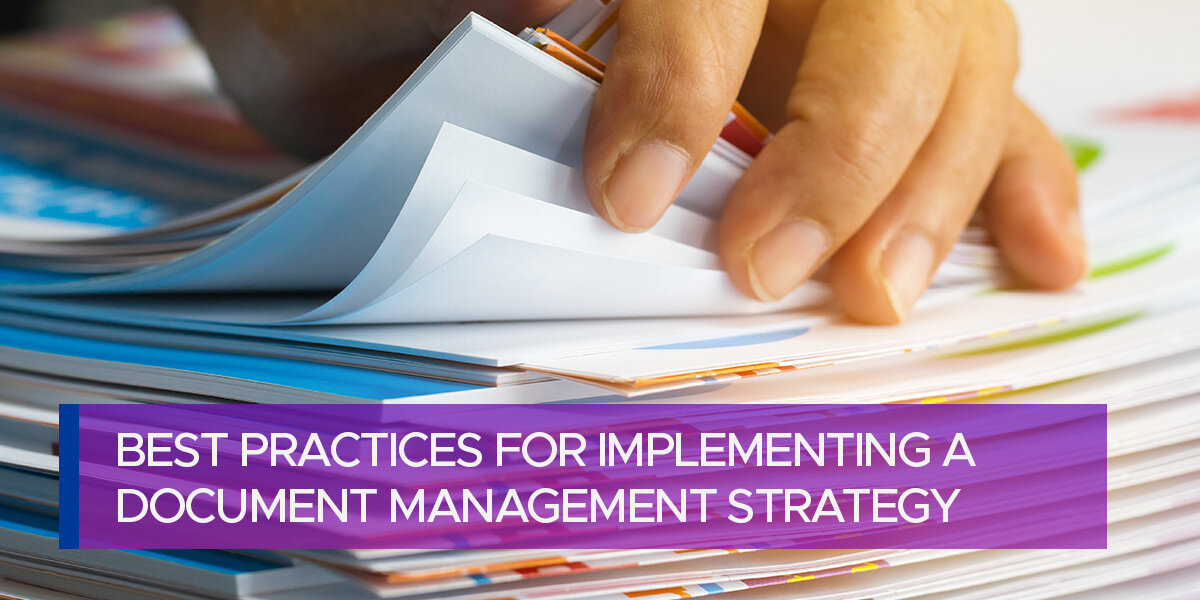
Best Practices for Implementing a Document Management Strategy
Documents are the lifeblood of the modern business, and a solid document management strategy can mean life or death for an office workflow. As companies are expected to handle more documents, faster and accurately, the challenge of keeping it all together gets more and more complicated.
Likewise, document management is far more than just print, copy, scan, email, repeat. Surprised? Here’s a closer look at the nitty gritty of document management, and why document management best practices are non-negotiable for any modern business.
The Evolution of Document Management
Frustrated at the pile of paperwork slowly accreting to the top of the filing cabinet? It’s an ancient problem. Early library classification systems in China and the Middle East suggest that efforts to keep documents organized have been evolving for a little over two thousand years. While businesses hopefully no longer keep records in cuneiform on stone tablets, document management continues to represent a core process for organizations which handle large amounts of information – like libraries and most modern offices.
Library document management lent its first major innovation to offices in 1877 when Melvil Dewey – inventor of the Dewey Decimal System – created the prototype for the first vertical filing cabinet. Paper cabinets for offices at this time laid papers horizontally. A spring-loaded panel kept these papers flat but had the disadvantage of occasionally destroying a document when trying to remove it. By 1900, however, keeping documents flat was no longer a problem because Dewey’s vertical filing system had been imported into the office, where it remained an office staple for another 100 years.
Document management took another turn in the late 1970s with the invention of computers. Developers needed a way to keep files managed. Realizing the potential of these systems, then-current head of research at Xerox, George E. Pake, predicted a revolution within the next 20 years which resulted in television displays on every office desk which could recall documents with a single button. He was right. Electronic document management systems were born.
What to Look for in a Document Management Provider
1. Industry-specific expertise and specialization.
Just because all companies have documents to manage doesn’t mean that one management strategy fits every company. Choose a document service provider which has demonstrated knowledge in the industry specific to an organization.
2. Demonstrated skill in developing bespoke strategies.
Is the document management provider asking incisive, discerning questions about the company’s current processes? They should be. This indicates an attitude of approaching document management from the perspective of a detective, which goes a long way in uncovering undetected problems or needs.
3. A variety of tools, techniques, and capabilities.
Does the document management provider offer a modular approach to their solutions? Management providers with a variety of resources available are better equipped to make specific suggestions which enhance the document management strategy of each client. Consider the breadth of offerings available when choosing between multiple providers.
4. Access to modern, up-to-date hardware and software.
Modern businesses need modern tools – that isn’t optional. The use of modern hardware and software indicates a document management provider’s commitment to ensuring the strongest security, most recent compliance standards and best overall experience possible. It also means this provider has the stability and longevity necessary to develop long-term relationships with its clients.
Tips for Working with a Provider to Develop a Solid Document Management Strategy
- Develop a relationship with the document management provider. Good vendors will not only learn the precise workflows and processes of each individual client, but they will work with existing practices to make them better.
- Ask questions. Approach the document management strategy from a collaborative perspective, rather than a top-down approach. A good vendor works with rather than takes control of the process.
- Prepare for a culture shift. Organizations which follow rote procedures often don’t recognize when needs change, but habits remain the same. An updated document management strategy may change certain processes and elicit a culture shift. Embrace this shift. It’s an evolution.
- Understand what document management providers do. A good document management provider will help a business adopt processes and infrastructure necessary to effectively manage the document process. However, this shouldn’t be a burden on either the vendor or the client.
- Follow the plan. Once a document management strategy is in place, it only works if procedures are followed. Commit to the strategy, then watch processes streamline and business grow.
VBS Has 60 Years of Experience Revolution Document Management
This article has covered some document management strategy and best practices. Hopefully, it has provided insight into what makes a good document management provider. Every business needs a solid strategy for managing the ever-growing mountain of documents which modern business generates. However, with the right management process, this doesn’t need to be painful.
Virginia Business Systems is an expert in document management systems. Contact a specialist today to learn more.
